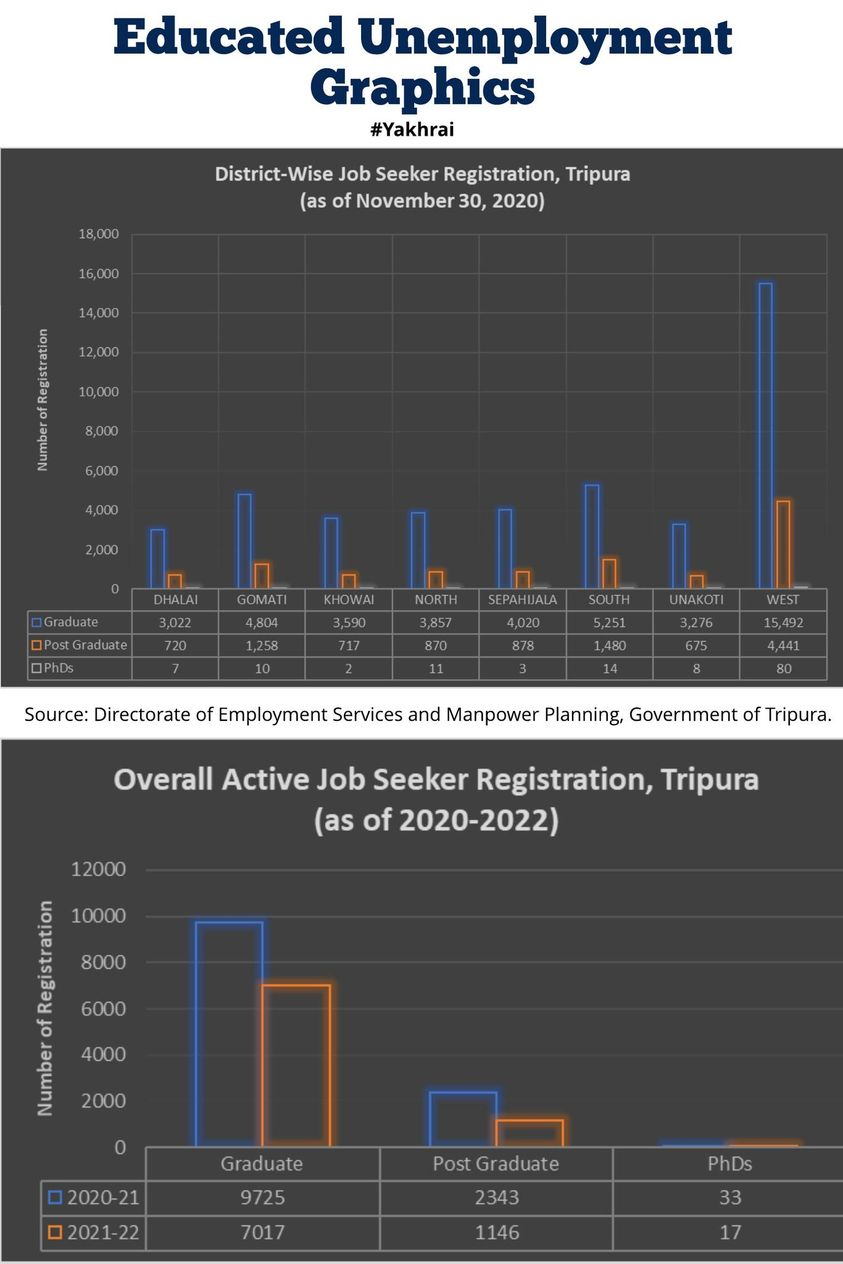By Dr. Benjamin Debbarma

Typically, youth unemployment is a global problem. Unemployment among young people begins when they are eligible to work. According to the International Labour Office (ILO), young people are increasingly having trouble when looking for their first job.The phenomenon of higher unemployment amongst the educated youth is not a recent phenomenon.
This is a short commentary piece of writing; I argue that the unemployment issues among Indigenous people of Tripura are often given false narrative or even misinterpreted. Even if the data or sources show that unemployment rates are low or high among the indigenous, such statistics do not necessarily imply that it is easy or harder for them to find a job. The indigenous youth unemployment stems mainly from the characteristics of they being educated have been structurally excluded in the enter of job market, either in government or privates sectors merely because of structured policy or agendas.
Tripura overall situation
I have focus among all streams graduates, post-graduates and PhD degree holders especially as because the rate among this groups remain high. Furthermore, those PhDs degree holders among indigenous youths remain high without any jobs, while their age does remain a factor- rising. The overall number of graduates, post-graduates and PhD degree holders as per the registered jobseekers remain high. The jobseekers registration may have declined, however the job seekers remain high and not necessarily the registration offer jobs so there are many who don’t register. The statistics of job seekers in Tripura by district-wise as shown in Table 1. This an overall figure not necessarily by category or else reservations. Rather, it has been taken to look at the scenario of the state as a whole.
Table 1: District-Wise Active Job Seeker Registration – by education qualification – Tripura, as 30 NOV, 2020.
| Tripura | DHALAI | GOMATI | KHOWAI | NORTH | SEPAHIJALA | SOUTH | UNAKOTI | WEST |
| Graduate | 3,022 | 4,804 | 3,590 | 3,857 | 4,020 | 5,251 | 3,276 | 15,492 |
| Post Graduate | 720 | 1,258 | 717 | 870 | 878 | 1,480 | 675 | 4,441 |
| PhDs | 7 | 10 | 2 | 11 | 3 | 14 | 8 | 80 |
Source: Directorate of Employment Services and Manpower Planning, Government of Tripura.
| Tripura | Graduate | Post Graduate | PhDs |
| 2020-21 | 9725 | 2343 | 33 |
| 2021-22 | 7017 | 1146 | 17 |
Source: Directorate of Employment Services and Manpower Planning, Government of Tripura.
Table 2 shows the overall numbers of graduates, post-graduates and PhDs those who are active jobseekers during the year 2020-2022.Overall, the unemployment rate in Tripura is 14.3 percent, according to the March 2023 Centre for Monitoring Indian Employment(CMIE) survey.
The paradox among Indigenous
Thus, among the indigenous educated youth there is a paradox. On one hand, educated are in search of suitable and sustainable jobs, their age is rising, and they want or need to enter the labour market on time and most of them are worrying. At the same time, employers seek more workers of their known candidates rather than the fresher’s.
But the narrative for Tripura indigenous especially amongst the educated remain shocking, excluded, marginalised of being have done or qualified from outside the state, Tripura. Perhaps, time has revealed the obsessions with the government jobs especially in higher education and actually realise it is with few sections who discriminate, bias during the selection processes and interviews. This kind of a phenomenon seems or might exclude, marginalize fresher’s skill and experience jobs seekers, and take away their right, ability to make their right time in job entry.
Limbo period
The length of the waiting period for proper jobs and what the young unemployed and underemployed do during that time is perhaps of some significance. Their mental makeup, their behaviour and their actions in their period of waiting are influenced by a varied set of factors. For example, it matters how their families treat them – which to some extent may depend on their financial status.
However, it is important to note that the clamour for jobs especially in teaching (colleges, university) is not just about the disillusionment amongst the youth due to their inability to find or be in competitive for other jobs (like TPSC, UPSC or any other competitive). It is worrying to see that the indigenous youth are unemployed. However, failing to provide opportunities for this bulge of young people as they enter the labour market risks the disaster of individual, family and society. Youth unemployment necessarily, can leads to various social problems. At the societal level, high youth unemployment endangers the functioning of social security systems.
Way forward
The challenge of improving the employability of educated indigenous youth by any government administration need to accessin fast tracing and direct interface between any industry, policy makers and higher institutions. Most of those educated indigenous youth need to be inclusively included in the state jobs be it government or private, as because their right of employability will merely be violated, making them more in favour of snatching their right, being marginalised in their own home state. However, immediate creation of adequate jobs do also requires from time to time. To conclude, there should be an integrated policy which focuses on promoting growth that supports theoverall livelihood.
Dr. Benjamin Debbarma, holds PhD degree from Centre for the Study of Regional Development, School of Social Sciences, Jawaharlal Nehru University, New Delhi, India.

I’m not sure exactly why but this website is loading extremely slow
for me. Is anyone else having this issue or is it a issue on my end?
I’ll check back later and see if the problem still exists.